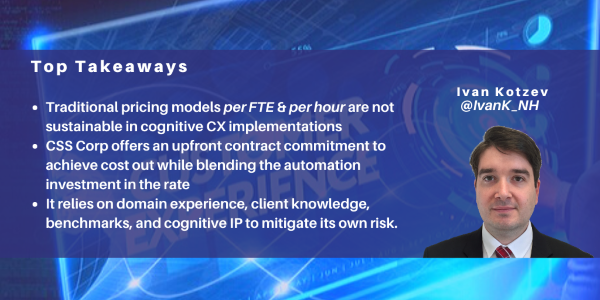Search posts by keywords:
Filter posts by author:
Related NEAT Reports
Other blog posts
posted on Nov 25, 2019 by Ivan Kotzev

One of the main challenges facing front-office automation projects is the adoption of commercial terms protecting the interests of both clients and CX services providers. In an industry dominated by traditional per FTE and per hour/minute pricing, to be successful, end-to-end digital transformation requires significant initial investments, new KPIs, a stake from the vendor, and a longer project horizon.
The cannibalization dilemma
Cost saving is a direct benefit of front-office automation, generated by deflecting traffic from live agents to self-service and improving productivity to enable reduction in required FTEs. Effective cognitive bots deployed in key customer journey stages or back-office workflow can eliminate the need for human intervention and decrease the volume handled, thus reducing vendors’ revenues.
So far, CX services providers have responded by absorbing the financial impact, hoping to protect their position from competitors, gain additional share of the client’s business down the road, or use it as a lever in the next renewal negotiation. However, this approach cannot be sustainable because cognitive CX is not an end solution but a continuous journey addressing customers’ increasing service expectations and growing acceptance of bots. Even in narrow-scope deployments, traditional performance metrics such as AHT lose their relevance when more complex and challenging interactions end up with human support.
Footing the robot bill
Clients commonly do not want to invest heavily upfront, especially when they do not know what outcomes to expect from CX automation. CSS Corp addresses this pain point with an upfront contract commitment to achieve cost out while backloading most of the investment and blending it in the rate. The company’s commitment stems from its significant experience with the specific client and vertical and from its cognitive IP. For example, its first large-scale CX automation project was with an existing home networking client, which CSS Corp has supported since 2005 and is now the sole supplier. The digital transformation with the client evolved from several joint RPA implementations and simplifications such as screen scraping in the past to 22% TCO reduction through automation. The vendor’s domain experience in home networking with multiple clients, accumulated customer data, and digital assets integration practice gives it confidence to accept the risk.
In another example, for a U.S. VoIP service provider, CSS Corp manages sales, customer care, technical support, and retention. It is responsible for increasing sales, reaching retention numbers, maintaining credit per line, and achieving customer satisfaction levels. CSS Corp charges on a ‘cents per active line per month’ basis. The provider owns the automation and tools but has agreed on a penalty matrix for FCR, CSAT, retention rates, etc.
Contracting with ‘unknowns’
In cases where the domain is less mature for the provider, or the client RFP does not give access to internal data, cases, or existing infrastructure, CSS Corp utilizes reference information and demands a clear view of the internal development roadmap. An example is a hardware storage manufacturer which CSS Corp supports in APAC, U.S., India, and Europe with 200 employees. The contract is based on flat per hour pricing with targets to reduce the headcount by year, 1, 2, and 3 with an increasing rate per hour.
A vital element here is the realistic assessment of meaningful results to justify the cost to the client. When these results do not bring savings, the company contracts against customer satisfaction improvements delivered through the CX automation. CSS Corp’s best practice is to employ a conservative calculation in generic cases. For example, it underwrites only 14-16% TCO over three years when the level of automation is limited by the product, languages, or degree of customer base exposure to chatbots.
Workforce model for bot-human support
With both established and prospective clients, CSS Corp applies a workforce model based on the number of eliminated contacts, volume of self-service, percentage handled by a chatbot or voice bot, and efficiency improvement for technology augmented live agents. It also includes the usual quality and SLA terms. If the automation benefits do not materialize, the provider accepts the need to overstaff. If the benefits exceed targets, CSS Corp gains from the additional savings. For ROI calculation to come through, the contract duration typically needs to be three or more years. Also, to win the buy-in from the organization, CSS Corp shares its calculations and research data, conducts onsite consultations, and organizes workshops.
The proper due diligence from CSS Corp requires sign-off on the client product release and IT update schedule. For these requirements it works with marketing, product development, IT, and operations in addition to customer service departments. The client’s IT approval is crucial to ensure an alignment of deployment dependencies and timelines. For example, in one instance, the client’s delayed telephony upgrade pushed the introduction of parts of the automation components back by six months. Here, the outcome-based pricing kicked in only after the infrastructure upgrade was complete.
Co-innovation with pricing
CX automation programs require investments from the client and vendor, and advanced pricing models are a must to ensure ‘skin in the game’ from both sides. True co-innovation entails a more flexible commercial approach which translates into a next-level CX services partnership.
NelsonHall will publish a Cognitive Customer Experience Market Analysis reports before the end of 2019.
